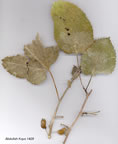| Moraceae |
 Morus alba |
| Morus L. Morus alba L. Ömür: Çok yıllık Yapı: ağaç Hayat formu: İlk çiçeklenme zamanı: 5 Son çiçeklenme zamanı: 5 Habitat: kültür Minimum yükseklik: -1 Maksimum yükseklik: -1 Endemik: - Element: ? Türkiye dağılımı: Türkiye Genel dağılımı: Çin ve Uzak Doğu Bulunduğu kareler:A1 A2 A3 A5 A6 A7 A8 A9 B1 B2 B5 B7 B8 C2 C5 C6 C7 C9 |
| M. alba L., Sp. Pl. 986 (1753). Syn: Af. sylvestris Forsskål, Fl. Aeg.-Arab. (Fl. Const. 33) (1775); M. constantinopolitana Hort. ex Poiret in Lam., Encycl. 4:381 (1797); M. byzantina Sieber ex Steudel, Norn. ed. 2, 2:162 (1841). Ic: Bonnier, Fl. Compl. Fr., Suisse et Belg. 10: t. 550 (1929); Jáv. & Csap., Ic. Fl. Hung. 112 (1930). Tree to 15 rn with slender glabrous shoots. Leaves ovate to broadly ovate, 6-10(-l 8) cm, acute or shortly acuminate, rounded or obliquely cordate at base, undivided, lobed or sinuate, crenate-dentate with rounded teeth, thin, soft, mostly glabrous on both sides but with tufts of hairs in axils beneath. Petiole l-3.5(-4) cm. Peduncle c. as long as syncarp. Fruit (syncarp) 1-2.5 cm, white, pinkish or purplish. Fl. 5. Cultivated. Described from China (Hb. Linn. 1112/1,2). Widely cultivated throughout Turkey and often naturalised. A1(E) Tekir-dağ: Gaziköy sirtlari, A. Baytop & Ertem (ISTE 19563)! A2(E) Istanbul: Mecidiyeköy to Ortaköy, Yalt. obs. A2(A) Bursa: Inegöl to Bursa, Yalt. obs. A3 Sakarya: Geyve, Kirim obs. A5 Amasya: Merzifon, Istanbullu obs. A6 Sivas: Koyulhisar, nr Sugözü, Pehlivan obs. A7 Trabzon: nr Akçaabat, Çetik obs. A8 Çoruh: Pertakrek (Peterek), 915-1525 m, C. Koch. A9 Kars: 8 km from Iğdir to Tuzlaci (Aras valley), 900 m, D. 43628! B1 Izmir: Selçuk to Kuşadasi, Yalt. obs. B2 Manisa: Akhisar, Köktürk obs. B5 Niğde: Niğde, nr Fertek, Tuğcu obs. B7 Malatya: Pötürge, Bağlar obs. B8 Siirt: Goro nr Sason, Hand.-Mazz. C2 Denizli: Honaz Da. nr Menteşe, E. Tuzlaci (ISTE 28056)! C5 Içel: S.W. of Tarsus, It. Leyd. 1959:1173! C6 Gaziantep: Gaziantep, nr Dut-luk, Kördere obs. C7 Adiyaman: Besni and Kahta, Kaleağasi obs. C9 Hakkari: Zap gorge, 34-45 km from Çukurca to Hakkari, 900-1000 m, D. 44783! Native to China and the Far East. The white mulberry (in Turkish, 'Akdut') is a beautiful tree, with a dense round head, cultivated for its fruits which are eaten fresh or dried and for its foliage which provides food for silkworms. Yellowish-brown heartwood and yellow sapwood is used for making musical instruments (in Turkish, 'Bağlama'). In E. Anatolia, the fruit is also made into syrup ('pekmez'). |